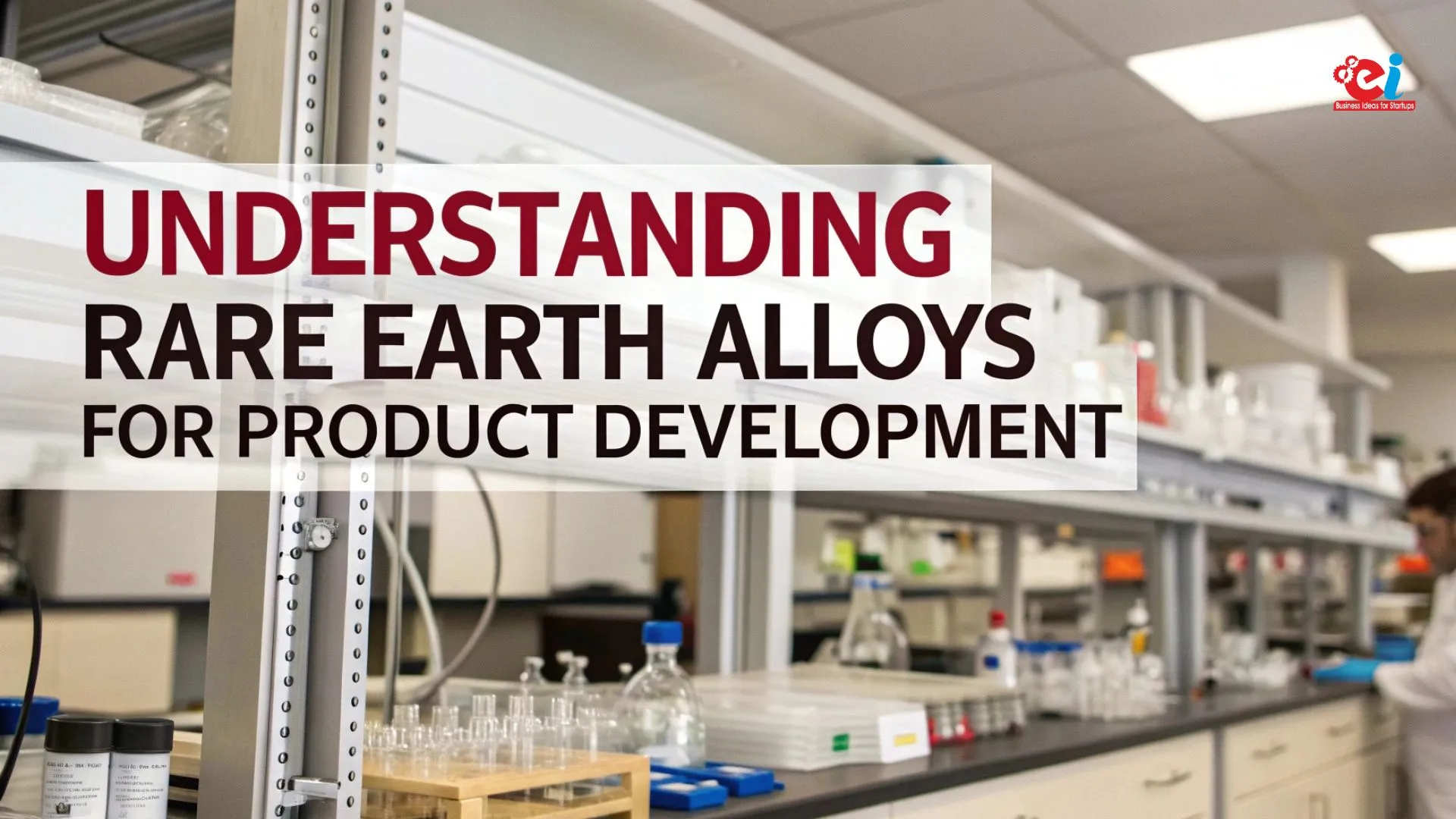Innovation Through Rare Earth Alloys
An innovation breakthrough requires materials with advanced capabilities, anisotropic performance metrics, and enhanced design flexibility. In modern times, the development of lightweight electronics alongside high-torque motors and ultra-sensitive sensors has been greatly aided by advanced Rare earth alloys. These alloys provide significant metallic compounds which require miniaturization during power demands, thermal resistance with minimal degradation during overheating, and functional integration in smart, digital, and green tech ecosystems.
Innovation in the chemistry field enables diversification into other disciplines as well. Understanding rare earth alloys for product development furthers empowers R&D units to make strategic material choices that effectively future-proof products. This transformation is guided by Hand Book on Rare Earth Metals & Alloys: Properties Extraction Preparation & Applications which focuses on provided engineering teams along with material scientists and entrepreneurs insight to design next generation devices.
Alloys and Their Components
Rare earth alloys vis a vis neodymium disprosium samarium or gadolinium elements alongside iron cobalt and boron demonstrate unmatched properties to conventional materials due to unique production magnetic conductive thermal along with luminescent capabilities.
Their high performance stems from rare earth elements due to their ability to generate strong magnetic fields, endure intense heat, or enhance charge transfer. These capabilities are advantageous in electronic design. For product developers, this translates to smaller motors and lighter batteries without losing power, reliability, and advanced smart sensors.
Related: Production of Ferrous and Non Ferrous Metals and Metal Products
How Rare Earth Alloys Enhance Product Capabilities
Integrating rare earth alloys into the new model often leads to increased output and greater environmental adaptability. A good example is the powerful compact NdFeB (neodymium-iron-boron) magnets that enable sleeker electric motors. Another example is Samarium-cobalt (SmCo) magnets that corrode less and work at high temperatures which makes them dependable in aerospace and defense systems.
Rare earth alloys can boost performance of photonic products, too. Their emission spectra makes europium and terbium-doped alloys useful in displays, lasers, and imaging devices och consumer electronics. With such materials added, a device’s clarity alongside color fidelity improves while battery consumption drops.
Industrial Product Categories Use Cases
Rare earth materials are essential parts of many modern products. In the automotive sector, they serve in the electric and hybrid vehicle drive systems and also in fuel injection technologies. They help to stabilize sensors as well as increase resilience in avionics for aerospace. Speakers and headsets as well as vibration motors and magnetic storage give electronics further benefits through alloy integration.
Medical devices such as MRI machines use advanced tuning and calibration components that contain rare earth materials alongside powerful magnets. Smart grid technologies and wind turbines also incorporate these alloys into their rotating parts and within their signal processing systems making them energy devices as well.
Some Common Design Applications Alloy Types
Such include among others:
- Gadolinium based alloys (Gd-based) are useful in neutron capturing which makes it ideal for nuclear reactors while serving other shooter uses like medical imaging.
- Samarium-Cobalt (SmCo) is widely utilized in high temperature operations hence perfect for military grade electronics made for aviation.
- Lanthanum-Nickel Alloys have application towards electrodes of batteries and hydrogen storage containers making them rather common within those fields.
- NdFeB is highly revered due to its strength meaning its found within motors, hard drives and earphones making it one of the most used.
The Handbook on Rare Earth Metals & Alloys provides designers with comparison graphs alongside application matrices containing mechanical, thermal along electrical properties allowing better choice tailored for performance sought after.
Design Consideration When Utilizing Rare Earth Alloys
When utilizing rare earth alloys, product developers need to take into consideration the performance benefits alongside the processing challenges. Many of these alloys exhibit high brittleness and reactivity, which makes them difficult to form, join, or finish. In addition, availability and recyclability must be considered within the larger context of environmental impact and materials efficiency over time.
Another opportunity comes with multifunctionality that combinations of several different functions can lead to smaller motors and lighter ones too. Motors can become much smaller and lighter while maintaining (or even improving) performance; sensors can become faster and more responsive; and energy systems can become denser in size while remaining powerful—but only if multidisciplinary cooperation is prioritized between material engineers and product teams as outlined in the handbook.
Engineering Requirements and Fabrication Methods
In order for engineering teams to fully integrate rare earth alloys into the product, there must be a firm understanding about materials fabrication methods. Some brittle NdFeB alloys oxidize easily which necessitates protective atmosphere or vacuum processing. Common fabrication techniques employed especially for magnet grade alloys are sintering, powder metallurgy, hot pressing.
Working with rare earth alloys comes with its own set of difficulties. To sustain accuracy, specialized tools, low feed rates, and coolants are required. To enhance surface stability as well as protection from corrosion, nickel or epoxy layer coatings may be applied. Engineers can access and avoid costly design errors by referring to The Handbook on Rare Earth Metals & Alloys which provides the fabrication parameters alongside quality control guidelines.
Integration into Prototyping and R&D Workflows
Structured experimentation is a requirement for prototyping with rare earth alloys. This goes beyond just having raw materials accessible as it poses challenges in selection, geometry refinement, environmental assessment and more because every step must account for their properties.
Such is the case with product teams working on micro actuators or MEMS sensors who need to ensure that components made using the alloy will withstand extreme thermal and magnetic forces for years to come. The handbook instructs R&D teams for pilot runs by detailing case studies with provided test parameters, measurement protocols, and functional validation benchmarks.
Problems in Product Development of Rare Earth Alloy
In spite of their performance benefits, rare earth alloys pose significant challenges in their practical use. The most notable are volatility in cost and sourcing limitations. Supply chain disruptions due to limited geography concentration – especially within China- can hinder development time or inflate production costs.
There are still performance trade-offs to consider. The strength of magnets made from neodymium and iron (NdFeB) may degrade with exposure to high temperatures unless stabilized with dysprosium, a rare and costly element. Developers are aided in their decision by the Handbook on Rare Earth Metals & Alloys that explores material trade-offs thoroughly, presenting choices based on calculated risks.
Balancing Sustainability and IP in Rare Earth Product Design
Product design requires balancing sustainability goals and regulatory compliance while using rare earth alloys. Recovery from waste after recycling is less than five percent for global usage of rare earths, but this gap is narrowing thanks to innovations in eco-refining, solvent-free processing, and lifecycle assessment approaches.
Sharp reductions in environmental impact can be achieved using alloy forms that are easier to recycle, working with suppliers committed to clean production, or reducing off-cuts. The handbook provides templates for lifecycle assessments as well as green alternatives for engineering processes while showcasing how to minimize the harmful impact of constituent parts on nature incorporated into components made of rare earth materials.
Developing intellectual property aims guides creation around compositions alterations or fabrication tweaks due to executive miniaturization offered by rare earth alloys given their outstanding traits. This evolution opens doors toward utility patents, design patents, or even process IPs making it a competitive edge.
Competitive Advantage for Startups and Engineering Firms
These materials can be used by startups and engineering companies to give them a distinct competitive edge. Opportunities for differentiation in the high-speed drone motor alloy blends and optimized magnet configurations used in medical devices are limitless. The handbook aids in the invention and confirmation of proprietary technologies by giving data on performance profiles of various alloys which helps developing new technologies.
Using the Handbook for Material Selection & Planning
The Handbook on Rare Earth Metals & Alloys is a comprehensive guide designed for hands-on use. It provides value to engineers and product teams by giving them:
- Evaluated charts of mechanical, thermal, and chemical properties.
- Tools for selective alloy applications based on their usage.
- Prototypical tests and evaluation methods.
- Diagrams depicting necessary machinery alongside processing steps.
- Integration issue solutions and problem diagnosing guides.
Such detail reduces developmental risk and decreases both time spent designing as well as accelerates movement from conception to commercialization.
Grab your copy of the book “Handbook on Rare Earth Metals and Alloys” here
Case Examples: Products Powered by Rare Earth Alloys
Rare earth alloys have powered countless innovations—often in ways that are not obvious at first glance. One example would be Tesla that has an EV motor incorporating NdFeB magnets providing torque efficiency while being compacted in size. Apple also leverages rare earth alloys miniaturization in the haptic engines they use both in iPhones and AirPods.
In the aerospace sector, satellites, drones, and other vehicles have relied on SmCo-based actuators and guidance systems owing to their stability under harsh conditions while remaining thermally slow-poke strung out Sluggish in heat-resiliency – performing coolly at ultra-hot temperatures—and therefore serve perfectly still logic swift calm steady docile sassy poised resilient strength a gentle steadfast presence residing within powerful buoyancy silently.
Other examples constituting remarkable innovative device enhancement enabling market leadership would involve rare-earth alloys integrated into medical technologies such as MRI scanners alongside robotic operated surgical tools enhancing precision markability all);
Developing Products With Alloys: Anticipating the Future
Growth in related regions, such as sensing devices and quantum computing, rely greatly on rare earth alloys to boost innovation. The anticipated changes will value smaller size packages that come with complex technologies within them. These alloys will be crucial for:
- Wearable Sensors
- Space Exploration Modules
- Actuators Embedded Smart Wearables
- Wireless Power Technologies
- Quantum Computing Hardware
With the introduction of triad manufacturing, rapid prototyping of intricate magnetic components through these alloys is made much easier. The provided handbook gives insights helping developers gain pioneer benefits during the weapon high tech competition.
Final Thoughts: Make Use of Rare Earth Alloys to Innovate Smarter
The evolution of product design processes starts by harnessing the alloys’ potential regarding performance and minimization of bulk materials. Applying these substitutes not only reinforce business strategy but embraced alloy strength while providing materials robustness enabling unprecedented applications.
Trust You’re Making Concealed Changes To Optimize Performance – This empowers innovators, designers and forward thinkers aiming to enhance product development with unmatched future ingredients while smoothly boosting effectiveness.






